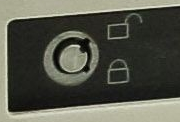
In old computers you may find different locks and keys
for them. Sometimes you won't have a key and you will need to turn the
lock. In many cases it is still possible by using tools not being a key
(method called "picking the lock") or using a different key.
If you plan to pick a lock, remember that you may not pick it second
time, so if you need to turn the "key" off and on once it's better
to short wires (of the lock is electronic).
First of all, small, circular locks (tubular locks) popular in PC cases and hard drive racks. Many times the only difference on key is the inward radius of a hole e.g. thickness of the tube of which the key is made. So many times you will wind that one or two keys open all locks you find.
Large circular locks, used to protect. e.g. some IBM computers casings, are more difficult. They need unique keys. The method to pick them is to apply rotating force while gently pressing 4 or 6 protrusions until they let go. This method requires usually some tool, but if you have luck they may be picked using a ball pen tube or even cardboard tube, if it fits tight on an inner bolt providing enough rotating force.


